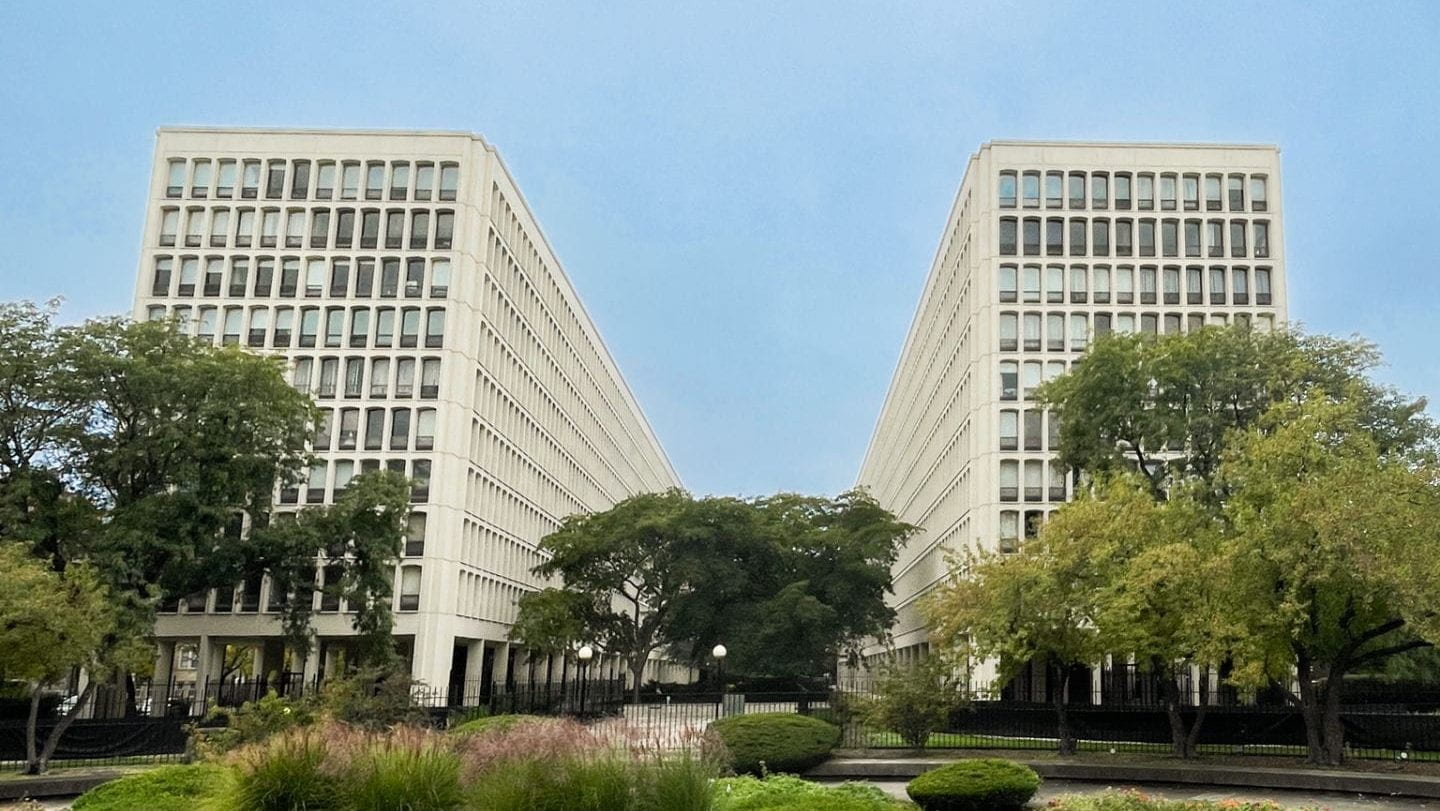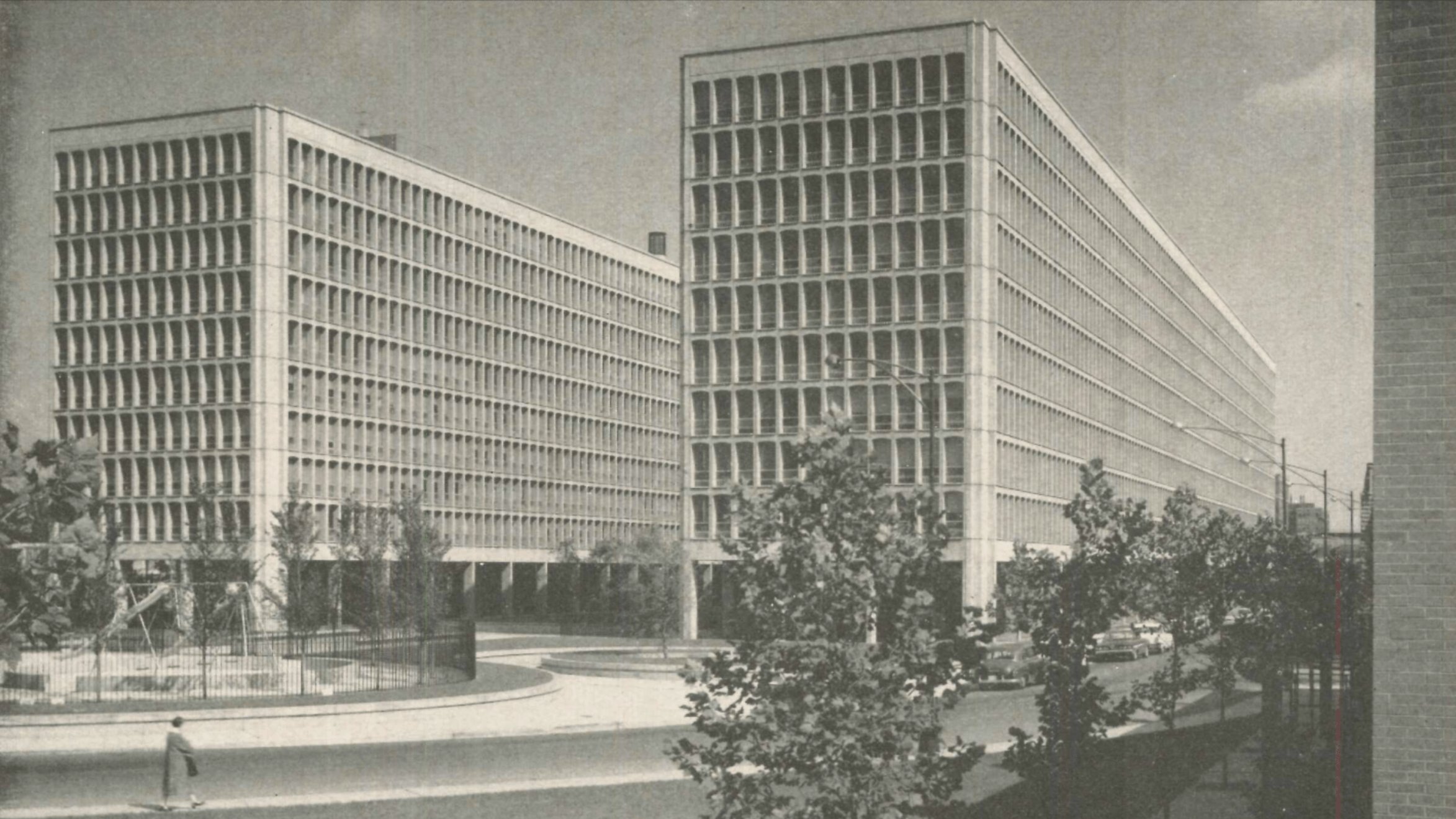University Park Condominiums, 2023. Photo by Brandon Shin.
If you walk down East 55th Street towards the lakefront, you’ll face a choice after passing Kenwood Avenue. Here, 55th Street splits into two one-way streets, curving around an apartment complex called the University Park Condominiums. Pick one side, and you won’t be able to reach the other for almost three blocks. As someone new to North American grid cities, I actually find comfort in city blocks that are not merely straight lines. It is, however, pretty annoying when I bike north or south and need to circle around the condos to get across 55th Street.
A pair of almost rectangular slabs of concrete run parallel to 55th Street and make up the two wings of the condos, giving the complex an interesting geometric presence. Much like the Ancient Greeks’ mythological names for constellations, University of Chicago students creatively call this “the toaster building” because of the parallel blocks. The funny name, however, gives us no indication of why the complex stands as such an intriguing obstacle.
University Apartments, 1962. Courtesy of Architectural Record.
The toaster building was not always an inconvenience. Its original conception was surprisingly aware of the need for accessible public space. Between the two wings of the condo is a garden that runs east-to-west along the original 55th Street. While this courtyard is no longer publicly accessible, that didn’t use to be the case. Originally, the renowned architect I.M. Pei designed the toaster building such that the garden in the middle would be a public walkway, almost a pedestrian continuation of 55th Street.1 The two wings of the complex are suspended over columns, leaving space on the ground floor to see into and walk through, so that the toaster building appears continuous with its environment. In 1978, the University Apartments became a condo, and owners quickly had security concerns that made them fence up the entire complex.2 At the same time, a private bathhouse and pool replaced the children’s playground on the west end of the public walkway.3 The idea of an open walkway on 55th Street was buried after two decades. Rather than a creative reclamation of public space, the toaster building became a barrier to circumvent.
Before the toaster building’s time and all its ensuing changes, 55th Street was like any other neighborhood main street throughout the first half of the 20th century. Families went for groceries before dinner, and people enjoyed bars and restaurants after work. Along the street, they could walk directly eastwards towards Lake Park Avenue without surprising turns. However, Hyde Park residents would soon hear about new plans for their community called “urban renewal.”
The University of Chicago was the primary force behind this push to redevelop parts of Hyde Park to counter apparent “urban deterioration.” Notably, Black immigration to the South Side of Chicago continued to increase in the 1940s and ‘50s, starting to diffuse into the edges of Hyde Park. This uncontrolled movement threatened the University’s vision of a stable, middle-class neighborhood for its faculty and students. On multiple fronts, the University set out to shape Hyde Park into a “compatible environment” for its self-interest as an academic institution.4
The toaster building was born as this story unfolded over the 1950s. It was conceived as part of “Hyde Park A,” one of the first in a series of renewal projects in the neighborhood. This decades-long pilgrimage towards a “renewed” Hyde Park is sometimes seen as a socially conscious turn in 20th-century urban developments since it presented its goal as “a stable, integrated neighborhood as an example for all.”5 This liberal façade helped Hyde Park distinguish itself from other South Side projects that almost exclusively displaced Black populations.6
In reality, institutional interests realized that the presence of Black residents was inevitable, so urban renewal’s “integration” was more focused on retaining white, upper-class Hyde Parkers than further inviting Black residents in. To prevent them from following the white flight towards the suburbs, Hyde Park A targeted an area around the intersection of 55th Street and Lake Park Avenue, notably creating a somewhat suburban enclave. As part of this broader project, the birth of the toaster building bulldozed 55th Street from Ridgewood Court to Harper Avenue. Quintessential to urban life, the demolished mixed-use buildings had a variety of stores nestled underneath residential units. Through urban renewal, they were replaced with bland residential complexes. The two sides of 55th Street opposite the toaster building became rows of identical townhomes. The remains of former commercial vibrancy was relegated to a suburban-esque strip mall at the intersection of 55th Street and Lake Park Avenue.
In a 1990s article, Ruth Knack, editor of the urban magazine Planning, praised Hyde Park’s urban renewal project for making the neighborhood more affluent while retaining racial diversity.7 Today, it stands as a signature middle class and racially-integrated neighborhood on the South Side. However, numbers reveal a more nuanced story. Even though the general Black population persistently hung above 30% of Hyde Parkers, the number of lower-income Black residents plummeted by 40% after redevelopment.8 In the relocation process, 46.1% of white families found accommodation within the neighborhood while only 16.8% of Black families could.9
The Hyde Park-Kenwood Community Conference, formed by local residents, functioned to shore up public support for the University’s schemes to control their neighborhood, but their acquiescence came back to bite them.10 Hyde Parkers were convinced by sensationalized crimes and fears of the area’s “deteriorating condition” in reference to Black immigration.11 They opted to be the quiet, residential backyard of a university instead of the vibrant community that once thrived. From mid-century urban renewal alone, 50 bars were uprooted from Hyde Park.12 The condo-ification of the University Apartments, though occurring a few decades after the brunt of urban renewal, traces a continuous lineage from the University’s attempts to create a pacified, secure upper middle class community. Every time I maneuver around the fenced up garden in the middle of 55th Street, it reminds me of the forces that compelled Hyde Park to conserve itself against the idea of an external invasion.13
Sometimes, the toaster building gets in the way between me and the 55 bus. When I have to watch the bus leave through the fences of the residential complex, I blame Hyde Parkers from the 1950s. And don’t get me started on all the bars and clubs that vanished under urban renewal. However, the University’s control of its environment is not simply a history. From the original Harper Court being replaced by a Hyatt development on 53rd Street to the Obama Presidential Center in Jackson Park refusing a community benefits agreement, the University’s policies of top-down redevelopment continue today. As this powerful institution continues to eat up Hyde Park and its surroundings, will this generation of Hyde Parkers—our generation—stay complicit?
University Apartments, 1962. Courtesy of Architectural Record.

- Margaret Duggar, “National Register of Historic Places Registration Form: University Apartments,” National Park Service, July, 2004, https://web.archive.org/web/20131203044720/http://gis.hpa.state.il.us/pdfs/223397.pdf.
- Ibid, section 7 page 5.
- Ibid.
- Arnold Hirsch, “A neighborhood on a hill: Hyde Park and the University of Chicago,” in Making the Second Ghetto: Race and Housing in Chicago, 1940 – 1960 (Chicago: University of Chicago Press, 1983), 137.
- Ibid, 166.
- Digital Scholarship Lab, “Renewing Inequality,” American Panorama, ed. Robert K. Nelson and Edward L. Ayers, accessed September 24, 2023, https://dsl.richmond.edu/panorama/renewal/#view=0/0/1&viz=cartogram&city=chicagoIL&loc=14/41.8000/-87.5951&project=2466.
- Duggar, “Registration Form.”
- Mohammad Chaichian, “A Walled Academic Urban Fortress: Using Neoliberal Urban Policies to Redesign and Maintain Chicago’s Hyde Park Neighborhood,” Spaces and Flows: An International Journal of Urban and ExtraUrban Studies 8, no. 4 (October 2017), https://doi.org/10.18848/2154-8676/CGP/v08i04/31-58.
- Hirsch, “A neighborhood on a hill,” 169.
- Ibid, 138.
- Ibid, 143 and 145.
- John Greenfield, “The Night the Lamps Went Out in Hyde Park,” Chicago Reader, October 5, 2000, https://chicagoreader.com/news-politics/the-night-the-lamps-went-out-in-hyde-park/.
- Hirsch, “A neighborhood on a hill,” 136.
Bibliography
Chaichian, Mohammad. “A Walled Academic Urban Fortress: Using Neoliberal Urban Policies to Redesign and Maintain Chicago’s Hyde Park Neighborhood.” Spaces and Flows: An International Journal of Urban and ExtraUrban Studies 8, no. 4 (October 2017). https://doi.org/10.18848/2154-8676/CGP/v08i04/31-58.
Contreras, Luke. “The Lululemonification of Hyde Park.” The Chicago Maroon, November 26, 2021. https://chicagomaroon.com/28747/viewpoints/column/lululemonification-hyde-park/.
Davis, Susan. “Lost Hyde Park: The Commercial Core.” Hyde Park Herald, September 14, 2021. https://www.hpherald.com/news/local/lost-hyde-park-the-commercial-core/article_d282cc80-14ba-11ec-b846-f786cbbb9339.html.
Davis, Susan. “Lost Hyde Park: Land clearance.” Hyde Park Herald, January 21, 2022. https://www.hpherald.com/news/local/lost-hyde-park-land-clearance/article_64703e2e-7240-11ec-b986-ebf650131a4d.html.
Digital Scholarship Lab, “Renewing Inequality.” American Panorama, edited by Robert K. Nelson and Edward L. Ayers. Accessed September 24, 2023. https://dsl.richmond.edu/panorama/renewal/#view=0/0/1&viz=cartogram&city=chicagoIL&loc=14/41.8000/-87.5951&project=2466.
Duggar, Margaret. “National Register of Historic Places Registration Form: University Apartments,” National Park Service, July 2004, https://web.archive.org/web/20131203044720/http://gis.hpa.state.il.us/pdfs/223397.pdf.
Farr Associates. “Harper Court.” Farr Associates. Accessed August 21, 2023. https://www.farrside.com/harper-court.
Greenfield, John. “The Night the Lamps Went Out in Hyde Park.” Chicago Reader, October 5, 2000. https://chicagoreader.com/news-politics/the-night-the-lamps-went-out-in-hyde-park/.
Hirsch, Arnold. “A neighborhood on a hill: Hyde Park and the University of Chicago.” In Making the Second Ghetto: Race and Housing in Chicago, 1940 – 1960, 135–70. Chicago: University of Chicago Press, 1983.
Kamin, Blair. “Remembering I.M. Pei: His spectacular buildings, his personal charm, and his Chicago slip-up.” Chicago Tribune, May 18, 2019. https://www.chicagotribune.com/columns/blair-kamin/ct-biz-im-pei-appreciation-kamin-0520-story.html.
Lowen, Lenore. “A Lesson on How To Do Urban Renewal The Right Way.” Preservation of Community Assets, January 15, 2014. http://historicpca.blogspot.com/2014/01/a-lesson-on-how-to-do-urban-renewal.html.
Napoles, Lisa. “Hyde Park A & B Urban Renewal Project.” Docomomo US, December 16, 2013. https://docomomo-us.org/news/hyde-park-a-b-urban-renewal-project.

